Banana Peel Based Cellulose Material for Agriculture and Aquiculture: Toward Circular Economy
Abstract
1. Introduction
2. Materials and Methods
2.1. Reagents and Equipment
2.2. Synthesis of Biopolymer from Banana Peels
2.2.1. Biopolymer Without Methionine
2.2.2. Biopolymer with Methionine
2.3. Characterization of Biopolymer
3. Results and Discussion
3.1. UV-VIS
3.2. Photoluminescence
3.3. FTIR Spectra
3.4. Thermal Analysis: TG and DTG Curves
3.5. Scanning Electron Microscopy (SEM)
4. Conclusions
Supplementary Materials
Author Contributions
Funding
Institutional Review Board Statement
Data Availability Statement
Acknowledgments
Conflicts of Interest
References
- Polprasert, C. Organic Waste Recycling: Technology and Management; IWA Publishing: London, UK, 2007. [Google Scholar]
- Mahjoub, B.; Domscheit, E. Chances and challenges of an organic waste–based bioeconomy. Curr. Opin. Green Sustain. Chem. 2020, 25, 100388. [Google Scholar] [CrossRef]
- Fiallos-Cárdenas, M.; Pérez-Martínez, S.; Ramirez, A.D. Prospectives for the development of a circular bioeconomy around the banana value chain. Sustain. Prod. Consum. 2022, 30, 541–555. [Google Scholar] [CrossRef]
- Zaini, H.M.; Roslan, J.; Saallah, S.; Munsu, E.; Sulaiman, N.S.; Pindi, W. Banana peels as a bioactive ingredient and its potential application in the food industry. J. Funct. Foods 2022, 92, 105054. [Google Scholar] [CrossRef]
- Wachirasiri, P.; Julakarangka, S.; Wanlapa, S. The effects of banana peel preparations on the properties of banana peel dietary fibre concentrate. Songklanakarin J. Sci. Technol. 2009, 31, 6. [Google Scholar]
- Gopi, D.; Kanimozhi, K.; Bhuvaneshwari, N.; Indira, J.; Kavitha, L. Novel banana peel pectin mediated green route for the synthesis of hydroxyapatite nanoparticles and their spectral characterization. Spectrochim. Acta A Mol. Biomol. Spectrosc. 2014, 118, 589–597. [Google Scholar] [CrossRef] [PubMed]
- Bishnoi, S.; Sharma, S.; Agrawal, H. Exploration of the potential application of banana peel for its effective valorization: A review. Indian J. Microbiol. 2023, 63, 398–409. [Google Scholar] [CrossRef] [PubMed]
- Mejouyo, P.W.H.; Harzallah, O.; Tagne, N.R.S.; Ndapeu, D.; Tchemou, G.; Drean, J.Y.; Njeugna, E. Development and analysis of completely biodegradable cellulose/banana peel powder composite films. J. Nat. Fibers 2019, 18, 151–160. [Google Scholar] [CrossRef]
- Pereira, M.A.F.; Cesca, K.; Poletto, P.; de Oliveira, D. New perspectives for banana peel polysaccharides and their conversion to oligosaccharides. Food Res. Int. 2021, 149, 110706. [Google Scholar] [CrossRef]
- Kharb, J.; Saharan, R. Development of biodegradable and eco-friendly fruit peel-derived bioplastic film with antibacterial potential for food packaging application. Biomass Convers. Biorefin. 2024, 15, 10839–10854. [Google Scholar] [CrossRef]
- Yaradoddi, J.S.; Patil, V.; Ganachari, S.; Banapurmath, N.; Hunashyal, A.; Shettar, A. Biodegradable plastic production from fruit waste material and its sustainable use for green applications. Int. J. Pharm. Res. Allied Sci. 2016, 5, 72–81. [Google Scholar]
- Maraveas, C. Production of sustainable and biodegradable polymers from agricultural waste. Polymers 2020, 12, 1127. [Google Scholar] [CrossRef] [PubMed]
- Hikal, W.M.; Ahl, S.A.; Hussein, A.H.; Bratovcic, A.; Tkachenko, K.G.; Sharifi-Rad, J.; Kačániová, M.; Elhourri, M.; Atanassova, M. Banana peels: A waste treasure for human being. Evid. Based Complement. Altern. Med. 2022, 2022, 7616452. [Google Scholar] [CrossRef]
- Katongole, C.B.; Sabiiti, E.; Bareeba, F.; Ledin, I. Utilization of market crop wastes as animal feed in urban and peri-urban livestock production in Uganda. J. Sustain. Agric. 2011, 35, 329–342. [Google Scholar] [CrossRef]
- Kalemelawa, F.; Nishihara, E.; Endo, T.; Ahmad, Z.; Yeasmin, R.; Tenywa, M.M.; Yamamoto, S. An evaluation of aerobic and anaerobic composting of banana peels treated with different inoculums for soil nutrient replenishment. Bioresour. Technol. 2012, 126, 375–382. [Google Scholar] [CrossRef]
- Gupta, G.; Baranwal, M.; Saxena, S.; Yadav, A.; Singh, R.; Pandey, S.; Kumar, A. Utilization of banana waste as a resource material for biofuels and other value-added products. Biomass Convers. Biorefin. 2023, 13, 12717–12736. [Google Scholar] [CrossRef]
- Wilaipon, P. The effects of briquetting pressure on banana-peel briquette and the banana waste in Northern Thailand. Am. J. Appl. Sci. 2009, 6, 167–171. [Google Scholar] [CrossRef]
- Fu, Y.; Freymueller, J.T.; Jensen, T. Seasonal hydrological loading in southern Alaska observed by GPS and GRACE. Geophys. Res. Lett. 2012, 39, L15303. [Google Scholar] [CrossRef]
- Krishna, A. An integrative review of sensory marketing: Engaging the senses to affect perception, judgment and behavior. J. Consum. Psychol. 2012, 22, 332–351. [Google Scholar] [CrossRef]
- Pagliano, G.; Ventorino, V.; Panico, A.; Pepe, O. Integrated systems for biopolymers and bioenergy production from organic waste and by-products: A review of microbial processes. Biotechnol. Biofuels 2017, 10, 113. [Google Scholar] [CrossRef]
- Leong, H.Y.; Chang, C.K.; Khoo, K.S.; Chew, K.W.; Chia, S.R.; Lim, J.W.; Show, P.L. Waste biorefinery towards a sustainable circular bioeconomy: A solution to global issues. Biotechnol. Biofuels 2021, 14, 87. [Google Scholar] [CrossRef]
- Awasthi, M.K.; Yan, B.; Sar, T.; Gómez-García, R.; Ren, L.; Sharma, P.; Zhang, Z. Organic waste recycling for carbon smart circular bioeconomy and sustainable development: A review. Bioresour. Technol. 2022, 360, 127620. [Google Scholar] [CrossRef]
- Tariq, Z.; Iqbal, D.N.; Rizwan, M.; Ahmad, M.; Faheem, M.; Ahmed, M. Recent advances in biodegradable polymers for sustainable applications. RSC Adv. 2023, 13, 24731–24754. [Google Scholar] [CrossRef]
- Olteanu, H.; Banerjee, R. Human methionine synthase reductase, a soluble P-450 reductase-like dual flavoprotein, is sufficient for NADPH-dependent methionine synthase activation. J. Biol. Chem. 2001, 276, 35558–35563. [Google Scholar] [CrossRef] [PubMed]
- Koleva, B.B. Solid-state linear-polarized IR-spectroscopic characterization of l-methionine. Vib. Spectrosc. 2007, 44, 30–35. [Google Scholar] [CrossRef]
- Das, K.; Ray, D.; Bandyopadhyay, N.R.; Gupta, A. Study of the properties of microcrystalline cellulose particles from different renewable resources by XRD, FTIR, nanoindentation, TGA and SEM. J. Polym. Environ. 2010, 18, 355–363. [Google Scholar] [CrossRef]
- Ishara, G.K.K.; Koliyabandara, P.A.; Samarakoon, G. Eco-friendly bio-composite sheets: A study on the utilization of banana peels, cassava starch, and banana stem fibers. Front. Sustain. 2024, 5, 1410986. [Google Scholar] [CrossRef]
- Woolf, P.J.; Fu, L.L.; Basu, A. vProtein: Identifying optimal amino acid complements from plant-based foods. PLoS ONE 2011, 6, e18836. [Google Scholar] [CrossRef]
- Cristiani, C.; Finocchio, E.; Rossi, L.; Giromini, C.; Dell’Anno, M.; Panseri, S.; Bellotto, M. Natural clays as potential amino acids carriers for animal nutrition application. Appl. Sci. 2021, 11, 5669. [Google Scholar] [CrossRef]
- Kumari, R.; Suman, K.; Karmakar, S.; Mishra, V.; Lakra, S.G.; Saurav, G.K.; Mahto, B.K. Regulation and safety measures for nanotechnology-based agri-products. Front. Genome Ed. 2023, 5, 1200987. [Google Scholar] [CrossRef]
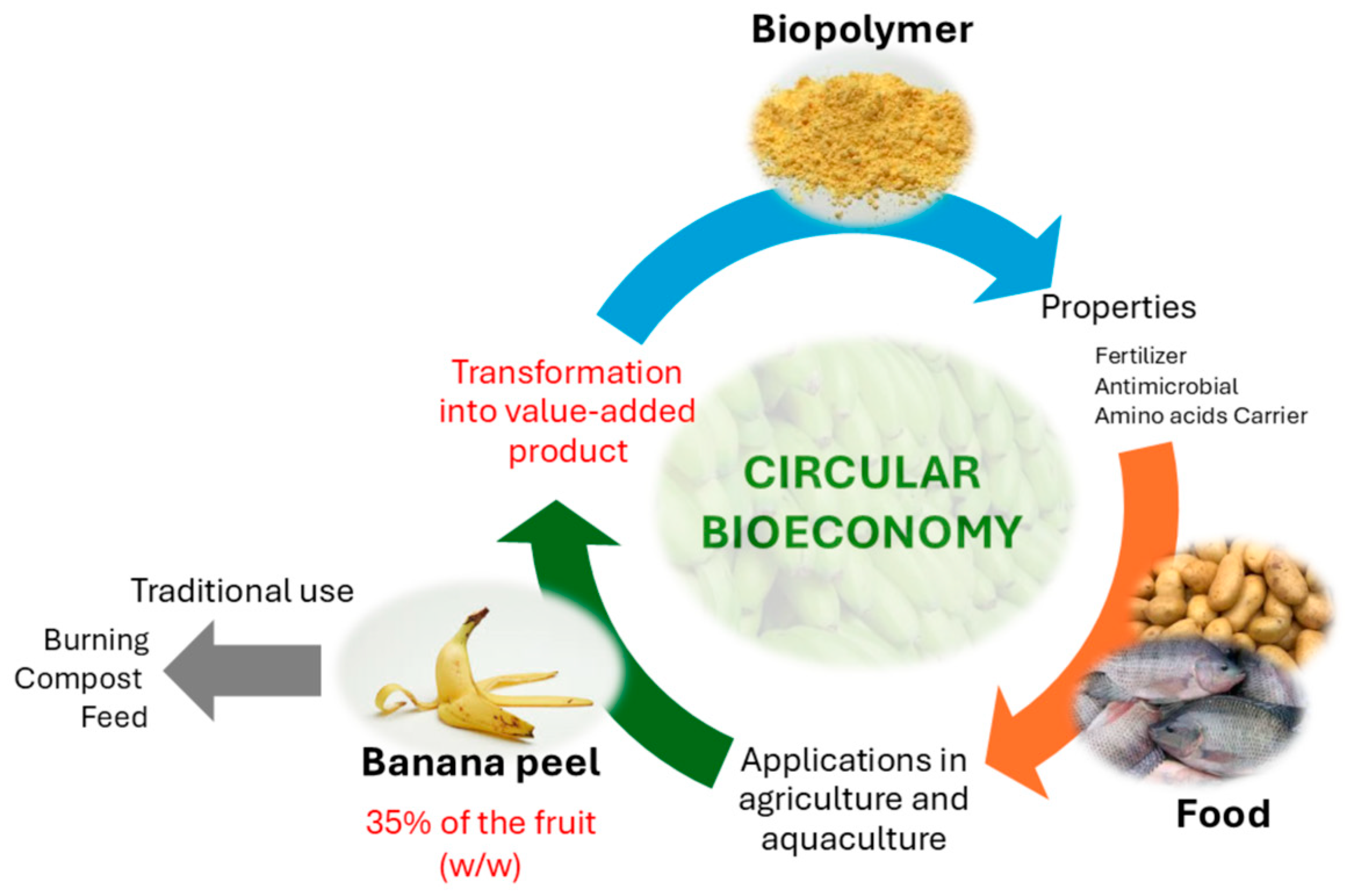
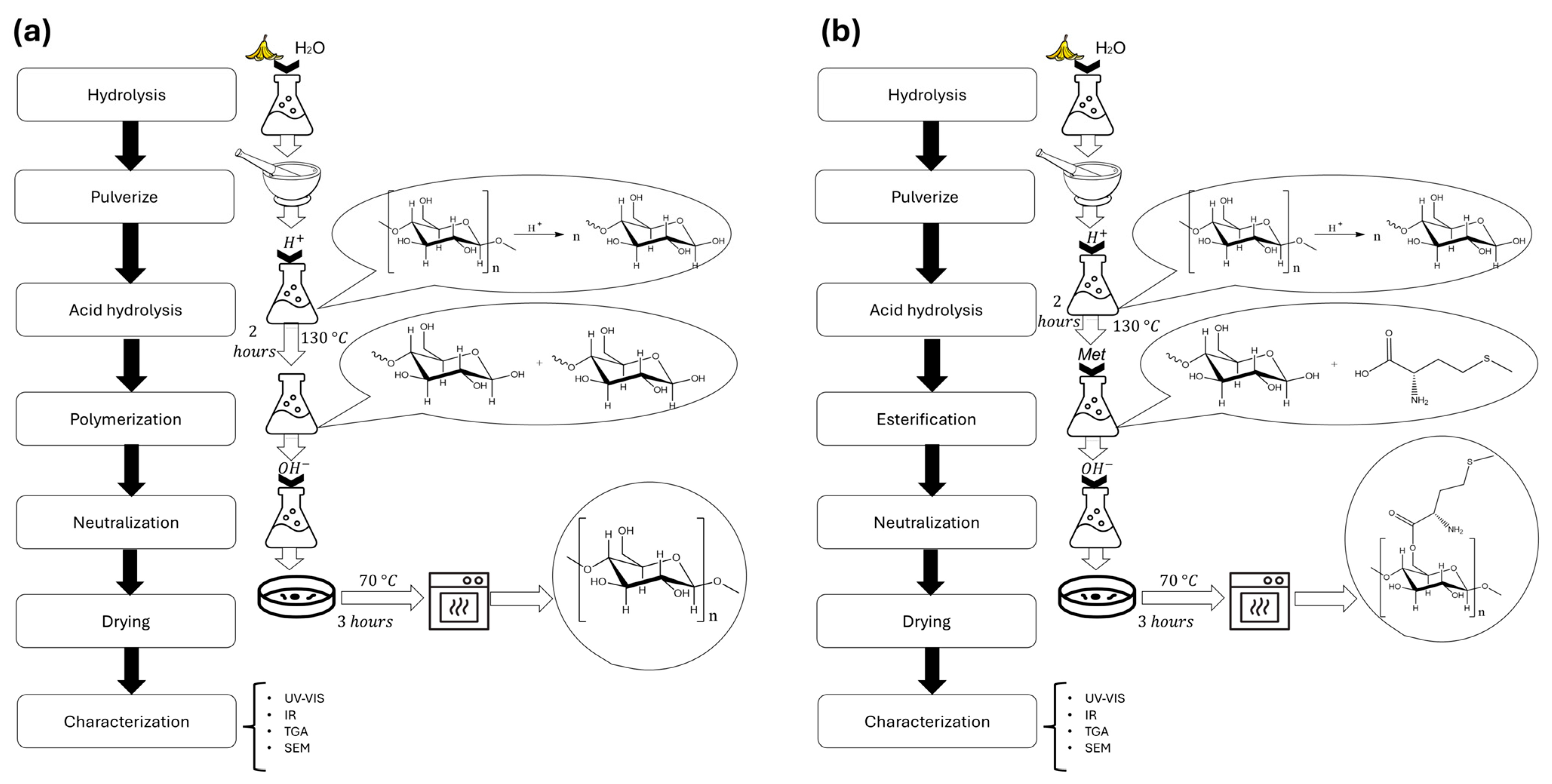
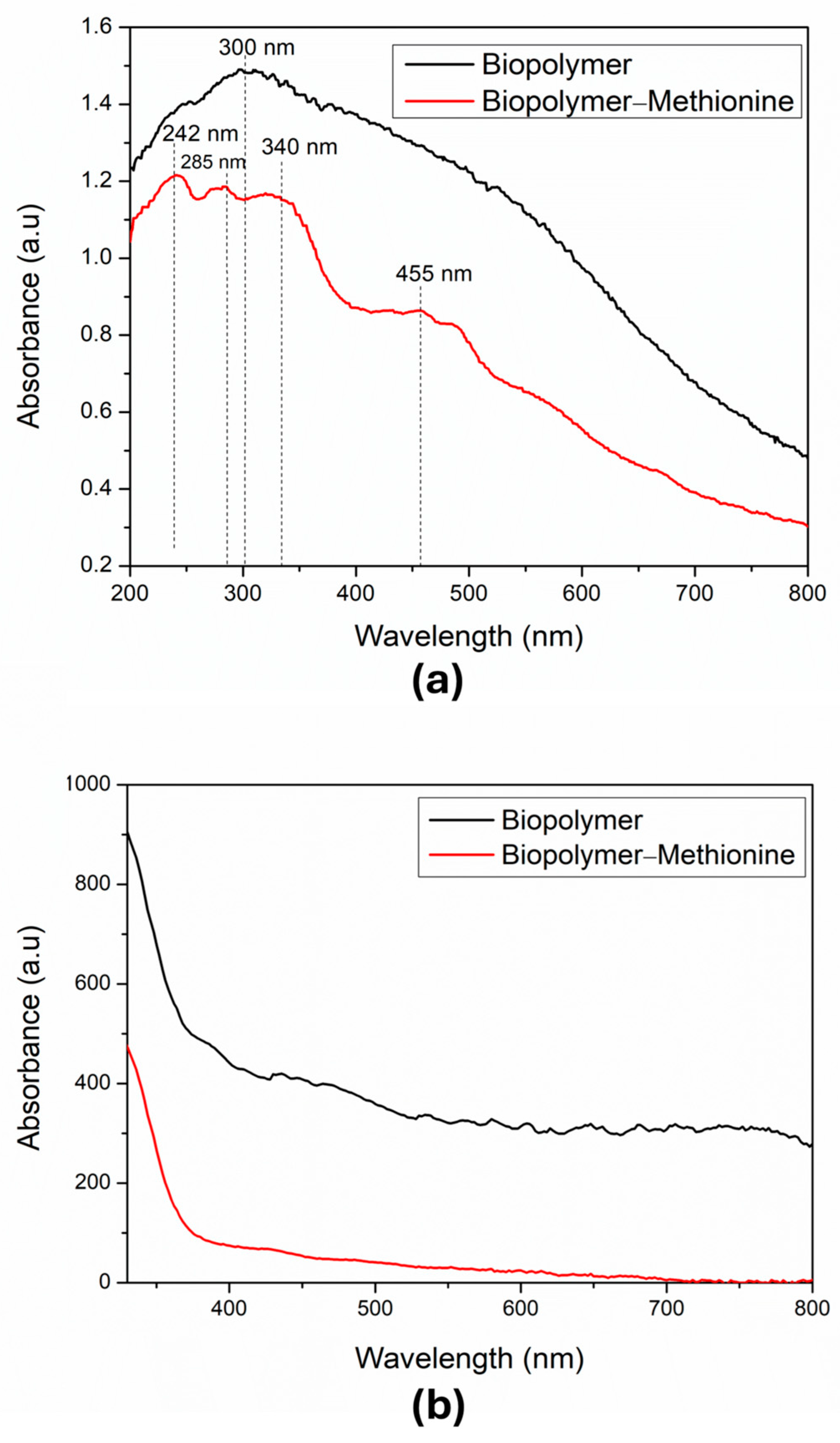


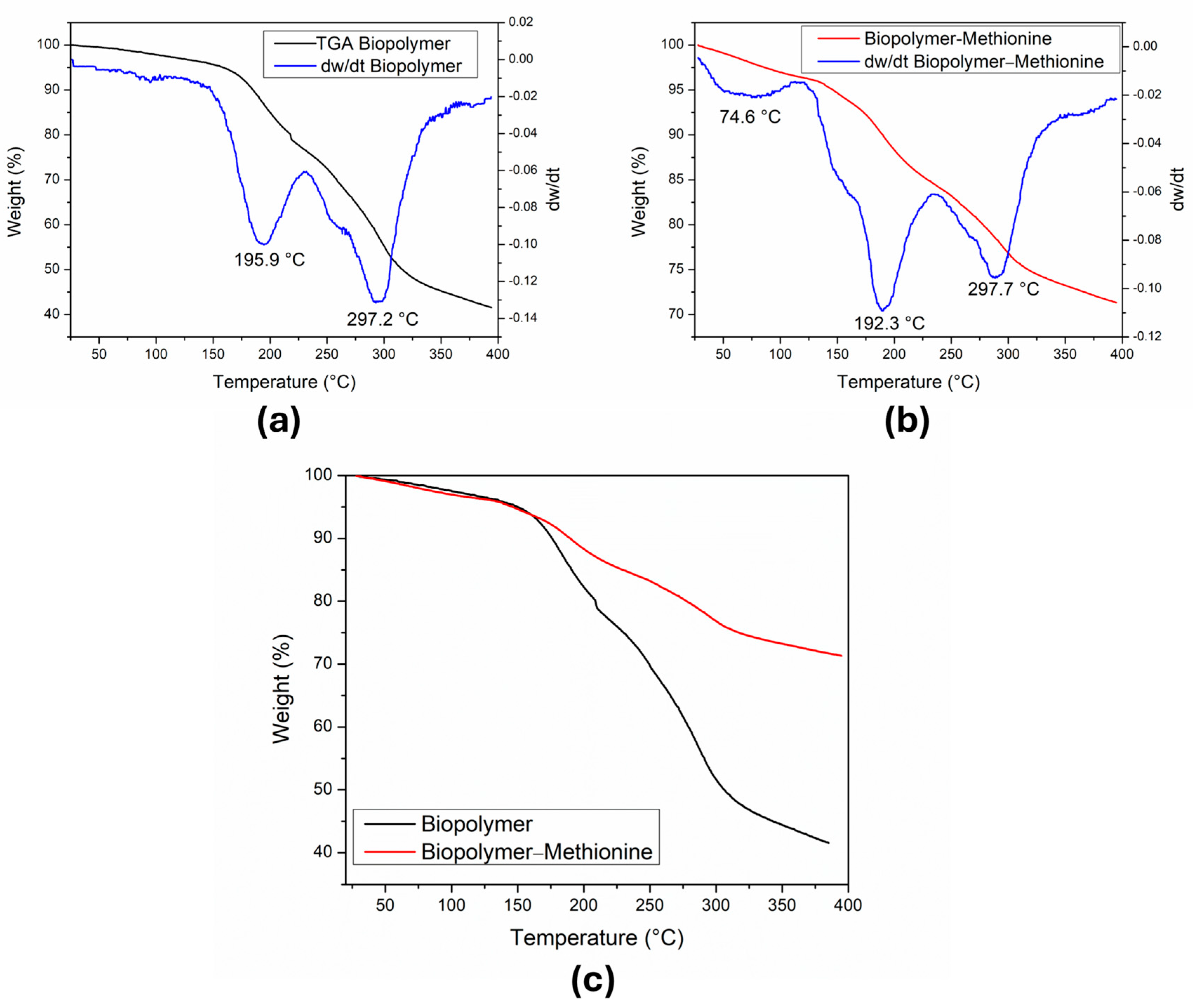

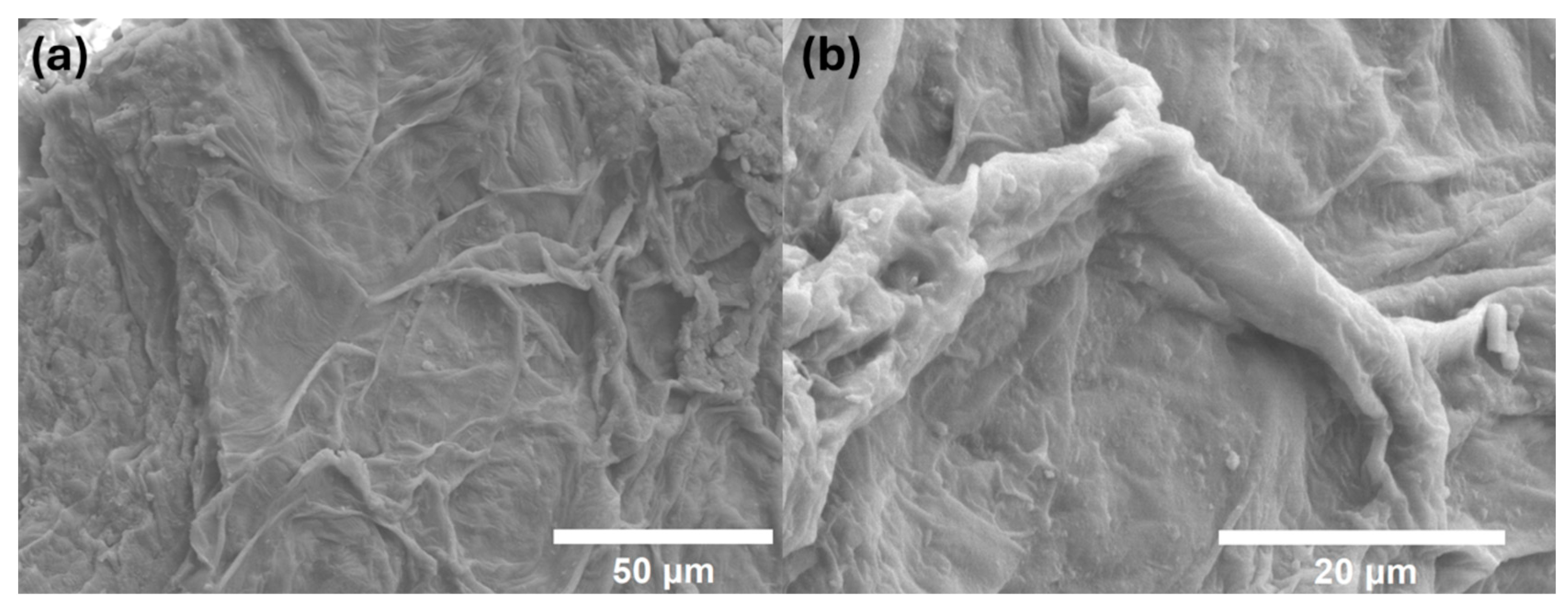
Disclaimer/Publisher’s Note: The statements, opinions and data contained in all publications are solely those of the individual author(s) and contributor(s) and not of MDPI and/or the editor(s). MDPI and/or the editor(s) disclaim responsibility for any injury to people or property resulting from any ideas, methods, instructions or products referred to in the content. |
© 2025 by the authors. Licensee MDPI, Basel, Switzerland. This article is an open access article distributed under the terms and conditions of the Creative Commons Attribution (CC BY) license (https://creativecommons.org/licenses/by/4.0/).
Share and Cite
Serratos, I.N.; García Torres, J.A.; Mendoza Téllez, J.L.; Silva Roy, D.; Soto Estrada, A.M.; Leyva López, N.E.; Rodríguez González, H.; Le Borgne, S.; Sánchez-Sánchez, K.L.; Sosa Fonseca, R. Banana Peel Based Cellulose Material for Agriculture and Aquiculture: Toward Circular Economy. Polymers 2025, 17, 1230. https://doi.org/10.3390/polym17091230
Serratos IN, García Torres JA, Mendoza Téllez JL, Silva Roy D, Soto Estrada AM, Leyva López NE, Rodríguez González H, Le Borgne S, Sánchez-Sánchez KL, Sosa Fonseca R. Banana Peel Based Cellulose Material for Agriculture and Aquiculture: Toward Circular Economy. Polymers. 2025; 17(9):1230. https://doi.org/10.3390/polym17091230
Chicago/Turabian StyleSerratos, Iris N., Juan Antonio García Torres, Jorge Luis Mendoza Téllez, David Silva Roy, Ana María Soto Estrada, Norma Elena Leyva López, Hervey Rodríguez González, Sylvie Le Borgne, Karla Lorena Sánchez-Sánchez, and Rebeca Sosa Fonseca. 2025. "Banana Peel Based Cellulose Material for Agriculture and Aquiculture: Toward Circular Economy" Polymers 17, no. 9: 1230. https://doi.org/10.3390/polym17091230
APA StyleSerratos, I. N., García Torres, J. A., Mendoza Téllez, J. L., Silva Roy, D., Soto Estrada, A. M., Leyva López, N. E., Rodríguez González, H., Le Borgne, S., Sánchez-Sánchez, K. L., & Sosa Fonseca, R. (2025). Banana Peel Based Cellulose Material for Agriculture and Aquiculture: Toward Circular Economy. Polymers, 17(9), 1230. https://doi.org/10.3390/polym17091230






